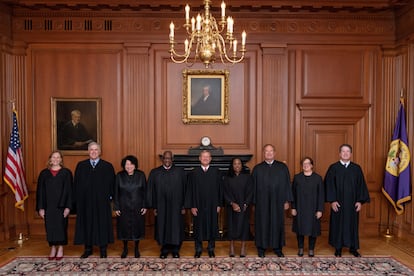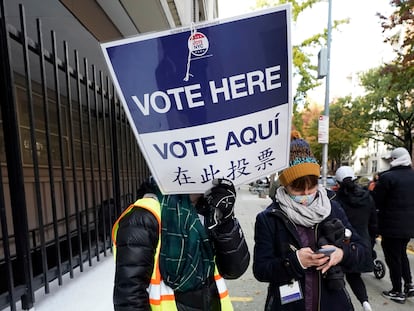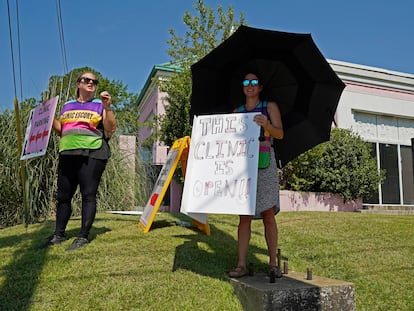US Supreme Court to tackle raft of new cases: From LGTBQ+ rights to affirmative action
The tribunal, which has a 6-3 conservative majority, will address key issues on religion, discrimination, race and the environment in the new judicial year


Starting this week, open oral hearings are back for a new judicial year at a conservative-led United States Supreme Court that will be dealing with decisive cases on race, religion, equality, electoral rules and environment that may entail a further tightening of last year’s firm turn to the right.
The last term ended with controversial rulings that repealed the right to abortion, undermined the fight against climate change, expanded the right to carry firearms, gave a greater role to religion in schools, questioned the mandatory vaccination of workers against Covid-19 and took power away from federal agencies. The court’s six conservative justices prevailed over the three progresssives, shifting the US further to the right. According to a Gallup poll, 58% of Americans disapprove of the court’s actions, an all-time high since the pollster began asking that question in 2000.
The most recent appointment to the Supreme Court is Ketanji Brown Jackson (the first Black woman to serve as a justice), 51, whose formal investiture was carried out on September 30. Nonetheless, the balance of forces does not change; she replaces fellow liberals Stephen Breyer, 84, who is retiring after nearly 28 years in office. And the court’s conservative majority is guaranteed to remain for many years, perhaps decades. Thanks to the maneuvers of the Republicans in Congress – which led some Democrats to claim that two appointments were “stolen” from them – Donald Trump was able to appoint three justices: Neil Gorsuch (55), Brett Kavanaugh (57) and Amy Coney Barrett (50). The position is for life (unless they decide to retire or are removed in an impeachment), and Trump chose relatively young people. Of the above, the oldest conservative justices are Clarence Thomas, 74, and Samuel Alito, 72.
The Supreme Court has until the end of June to issue its sentences, and usually there is an avalanche of decisions during that month. But traditionally, hearings begin on the first Monday in October. These are some of the most prominent cases that will mark the judicial year of the Supreme Court:
Environmental protection
Sackett v. EPA
The Sacketts have been trying to build a house on land they own in Idaho, near Priest Lake, for almost 15 years. Shortly after construction began, the Environmental Protection Agency (EPA) warned them that their land probably included wetlands and would therefore be subject to the 1972 Clean Water Act, which prevents the dumping of pollutants, as well as sand, cement and other materials. That legislation – not the clearest that Congress has approved – protects the “waters of the United States,” referring in principle to “navigable waters,” which in time extended to adjacent waters. But the question of what consituents “adjacency” remains unclear. Not even a 2006 Supreme Court case (Rapanos v. the United States) was able to clarify the matter. At the time, conservative justices Alito, Roberts and Thomas were in favor of a restrictive interpretation that would limit the power of the EPA to the cases of wetlands and creeks in which there is a continuous connection of surface water with navigable waters.
There is no water on the Sackett land. On the other side of the road that passes by their property there is a wetland that connects to a drainage ditch that leads to a non-navigable creek, which is connected with the lake. The EPA deemed the Sacketts’ land a protected wetland under the Clean Water Act and ordered them to remove the fill material under threat of a fine. The case became entangled in the courts, reached the Supreme Court for the first time for jurisdictional issues in 2012, then it stalled, and now the Sacketts are questioning before the high court whether or not the EPA has the authority to decide that their farm is a wetland under the Clean Water Act or, in a broader sense, if it does have the capacity to define what “navigable waters” are without Congress having expressly empowered it to do so.
Taking power away from federal agencies is a favorite sport for conservative judges, and with the 2006 precedent, the Sacketts may soon be able to build their house, as Alito, Roberts and Thomas only need two more justices to prevail.
Electoral rules and racial discrimination
Merrill v. Milligan
The second case examined by the Supreme Court affects the Voting Rights Act of 1965 and could be an example of how anti-discrimination laws could be used against the very communities they are meant to protect. What is being judged is an aggressive redistricting plan in Alabama. Every 10 years the census is reviewed and the states have the power to establish electoral districts based on population. They do it to favor their own party, a widespread practice known as gerrymandering.
Alabama is 27% Black, but the redesign left only one district (out of seven) with an African American majority. Section 2 of the Voting Rights Act prohibits electoral discrimination on the basis of race, and a lower court, recalling the state’s long history of discrimination, ordered that the redraw include a second majority Black district.
However, Alabama replied that it has not been proven that its electoral map is the result of racial issues, and that establishing a second majority Black district would violate precisely the right to equality enshrined in the 14th Amendment of the Constitution, because the state would be forced to consider the issue of race. The ruling may have implications in numerous states.
For the time being, the Supreme Court rejected the precautionary suspension of the new map in July; those districts will be the ones used in the legislative elections on November 8.
Affirmitive action
Students for Fair Admissions v. Harvard and Students for Fair Admissions v. University of North Carolina
A hearing has been set for October 31 to argue two parallel cases that question affirmitive action for minorities in access to universities. The Supreme Court has ruled on this matter in the past. In the landmark 2003 case Grutter v. Bollinger, the court held that that a student admissions process that favors “underrepresented minority groups” does not violate the Fourteenth Amendment’s Equal Protection Clause so long as it takes into account other factors evaluated on an individual basis for every applicant. But the fact that the conservative-led court has decided to accept similar cases is seen as an indication that it is willing to change this ruling.
John Roberts, the current president of the Supreme Court, wrote in a 2006 opinion that “the way to stop discrimination on the basis of race is to stop discriminating on the basis of race.” Affirmative action has allowed universities to consider race among other criteria to favor a greater diversity of students and, improve access for Black and Latino minority students. On the other hand, Asian American students, often with better grades, feel discriminated against by affirmative action.
The Students for Fair Admissions organization, founded by anti-affirmative action activist Edward Blum, is accusing Harvard of discriminating against Asian American students and the University of North Carolina of discriminating against white students and Asian Americans. Blum hopes that the justices will declare that the consideration of race in the university admission process violates the Equal Protection Clause.
Electoral rules: The power of state legislatures
Moore v. Harper
This is another key issue that is also related to gerrymandering. The North Carolina Supreme Court struck down the congressional map drawn by the Republican-led state legislature on the grounds that it was too partisan and artificial. The lawmakers appealed, citing the “independent legislature doctrine,” which argues that state legislatures alone have the power to set election rules.
The question is whether, when the Constitution speaks of “state legislatures,” it refers to all state branches (including the courts, the secretary of state and the governor) or exclusively to the state legislature. If it is the latter, the implications could be tremendous, as it would open the way to all kinds of more aggressive maneuvers by state lawmakers, with no judicial control.
Freedom of expression and LGBTQ+ discrimination
303 Creative LLC v. Elenis
Religion, gay rights, freedom of expression and culture wars come together in another important case that could overturn the 2018 landmark ruling Masterpiece Cakeshop v. Colorado Civil Rights Commission. That year, the Supreme Court ruled that a Denver baker could not refuse to make a couple’s wedding cake on the grounds that the customers were gay and that it was against their religious beliefs and freedom of expression.
Now, in another case from Colorado, a graphic designer is refusing to design web pages for same-sex marriages, alleging that it violates their freedom of expression enshrined in the First Amendment of the Constitution. Given the court now has a 6-3 conservative majority and is made up of justices who even question the right to same-sex marriage, the result may be different, which could open the doors to of all kinds of discrimination in the name of freedom of expression.
Race and adoption: Native American children
Haaland v. Brackeen
Racial issues will also be addressed in another case scheduled for hearing on November 9. The goal is to see if the preference given to Native American families to adopt children from their own community (over non-Native families) is constitutional. In 1978, Congress enacted the Indian Child Welfare Act to remedy the “alarmingly high” percentage of Native American families that are “broken up by the removal, often unwarranted, of their children from them by non-tribal public and private agencies.” Now, the states of Texas, Louisiana and Indiana, as well as several individuals, are questioning the constitutionality of that law for taking into account racial considerations when deciding on the adoption of children. The law however is strongly defended by the Cherokees and Navajos. Four concurrent claims arrived at the Supreme Court, because none was completely satisfied with the resolutions of lower courts, which annulled one part of the law and kept another.
Andy Warhol and the Prince silkscreens
Andy Warhol Foundation for the Visual Arts v. Goldsmith
Another of the first cases that will be dealt with (on October 12) has to do with copyright. Andy Warhol made a series of 16 silkscreens of pop star Prince from a photograph taken by Lynn Goldsmith in 1981. The renowned photographer filed a lawsuit alleging that her copyright had been violated. In the first instance, the judge rejected her case, pointing out that the transformation was such that it could be considered a new and original work. However, the appeals court overturned that ruling, stating that Warhol’s work retained the essential elements of the photograph, and did not have a “fundamentally different and new artistic purpose and character.”
Tu suscripción se está usando en otro dispositivo
¿Quieres añadir otro usuario a tu suscripción?
Si continúas leyendo en este dispositivo, no se podrá leer en el otro.
FlechaTu suscripción se está usando en otro dispositivo y solo puedes acceder a EL PAÍS desde un dispositivo a la vez.
Si quieres compartir tu cuenta, cambia tu suscripción a la modalidad Premium, así podrás añadir otro usuario. Cada uno accederá con su propia cuenta de email, lo que os permitirá personalizar vuestra experiencia en EL PAÍS.
¿Tienes una suscripción de empresa? Accede aquí para contratar más cuentas.
En el caso de no saber quién está usando tu cuenta, te recomendamos cambiar tu contraseña aquí.
Si decides continuar compartiendo tu cuenta, este mensaje se mostrará en tu dispositivo y en el de la otra persona que está usando tu cuenta de forma indefinida, afectando a tu experiencia de lectura. Puedes consultar aquí los términos y condiciones de la suscripción digital.
More information
Archived In
Últimas noticias
Most viewed
- Sinaloa Cartel war is taking its toll on Los Chapitos
- Oona Chaplin: ‘I told James Cameron that I was living in a treehouse and starting a permaculture project with a friend’
- Reinhard Genzel, Nobel laureate in physics: ‘One-minute videos will never give you the truth’
- Why the price of coffee has skyrocketed: from Brazilian plantations to specialty coffee houses
- Silver prices are going crazy: This is what’s fueling the rally










































